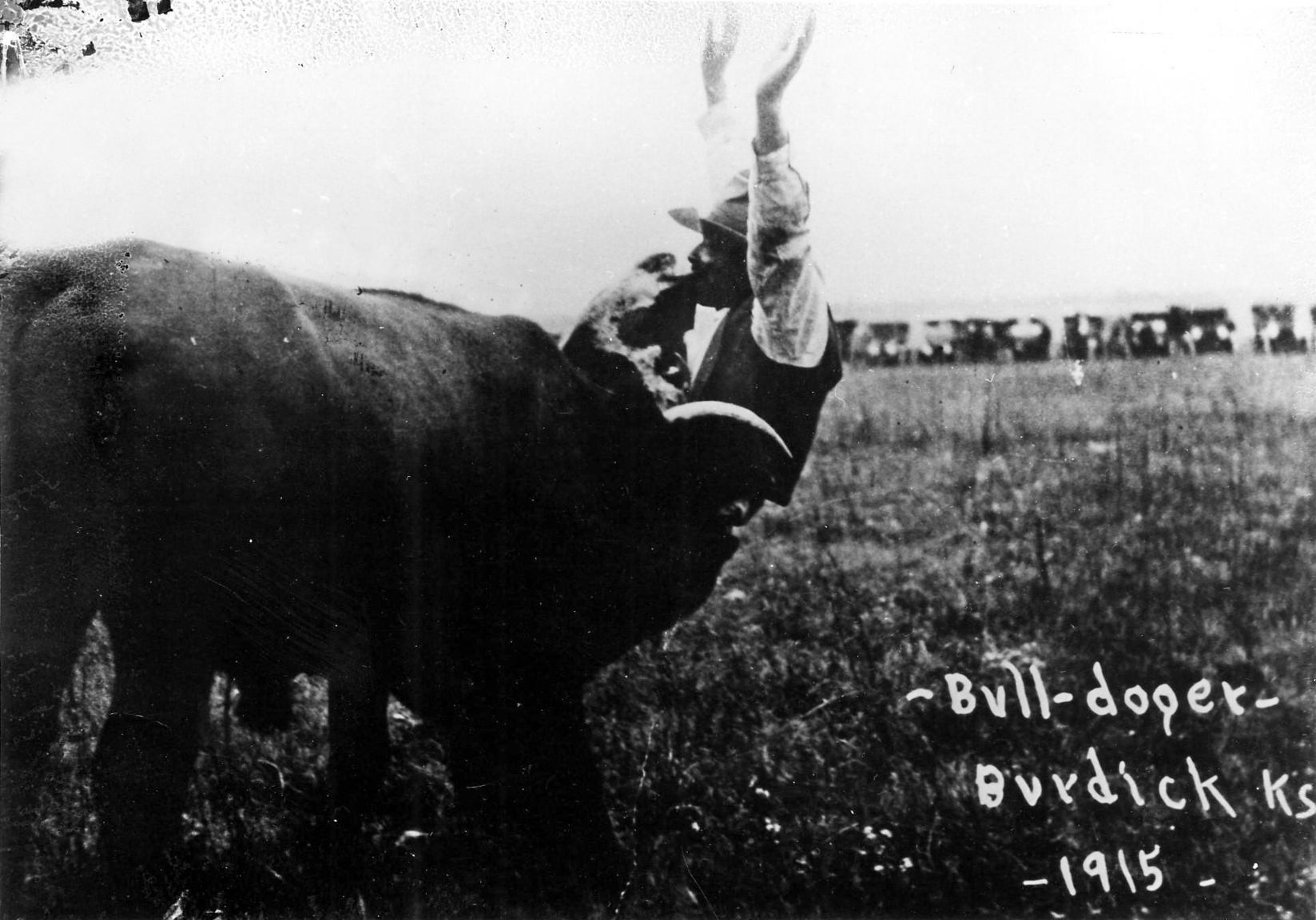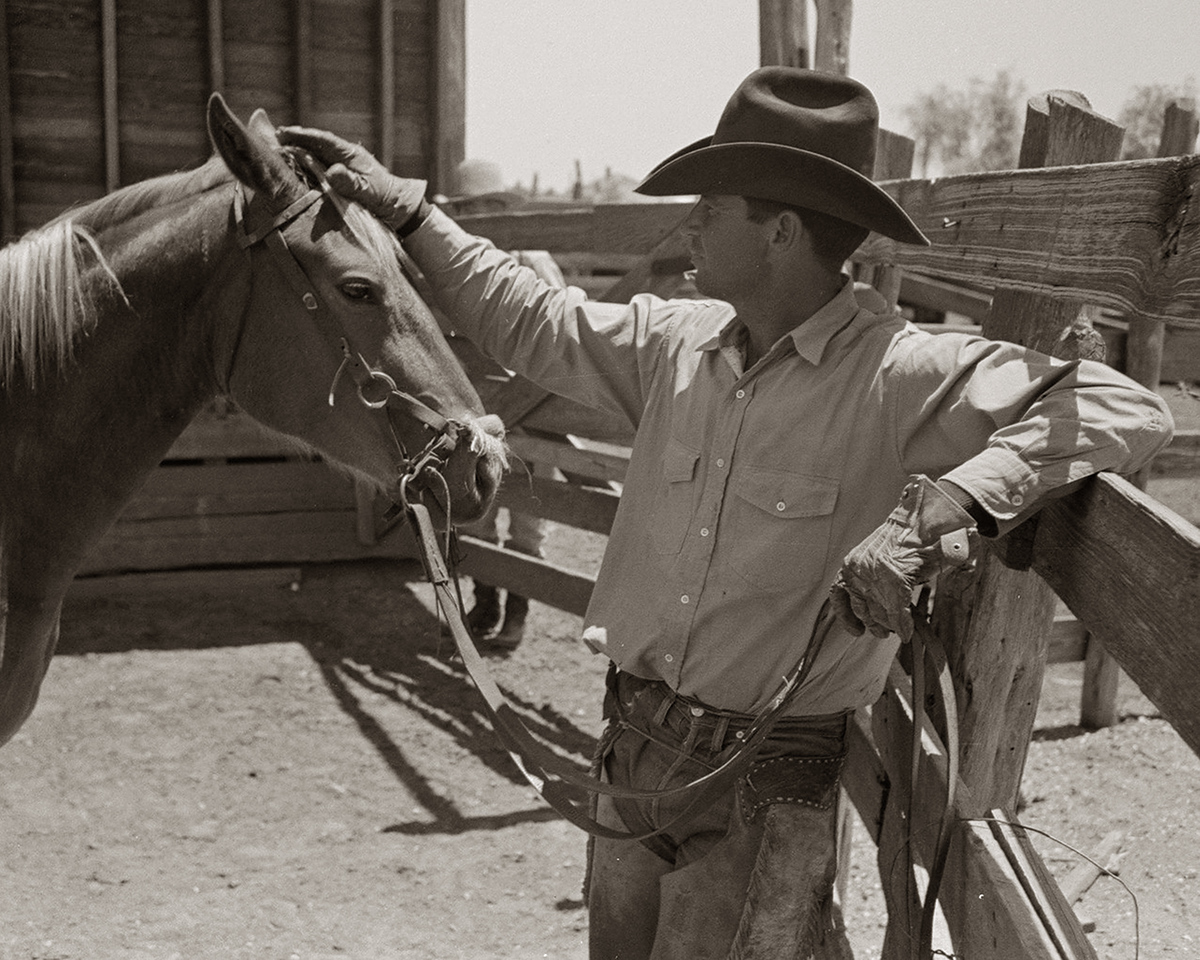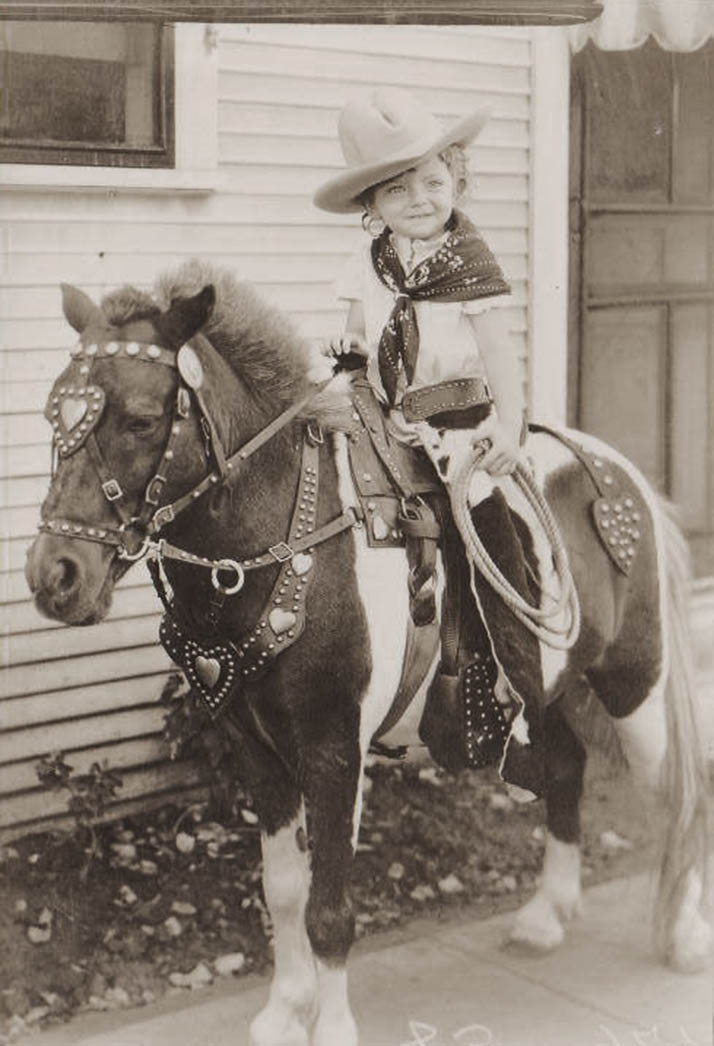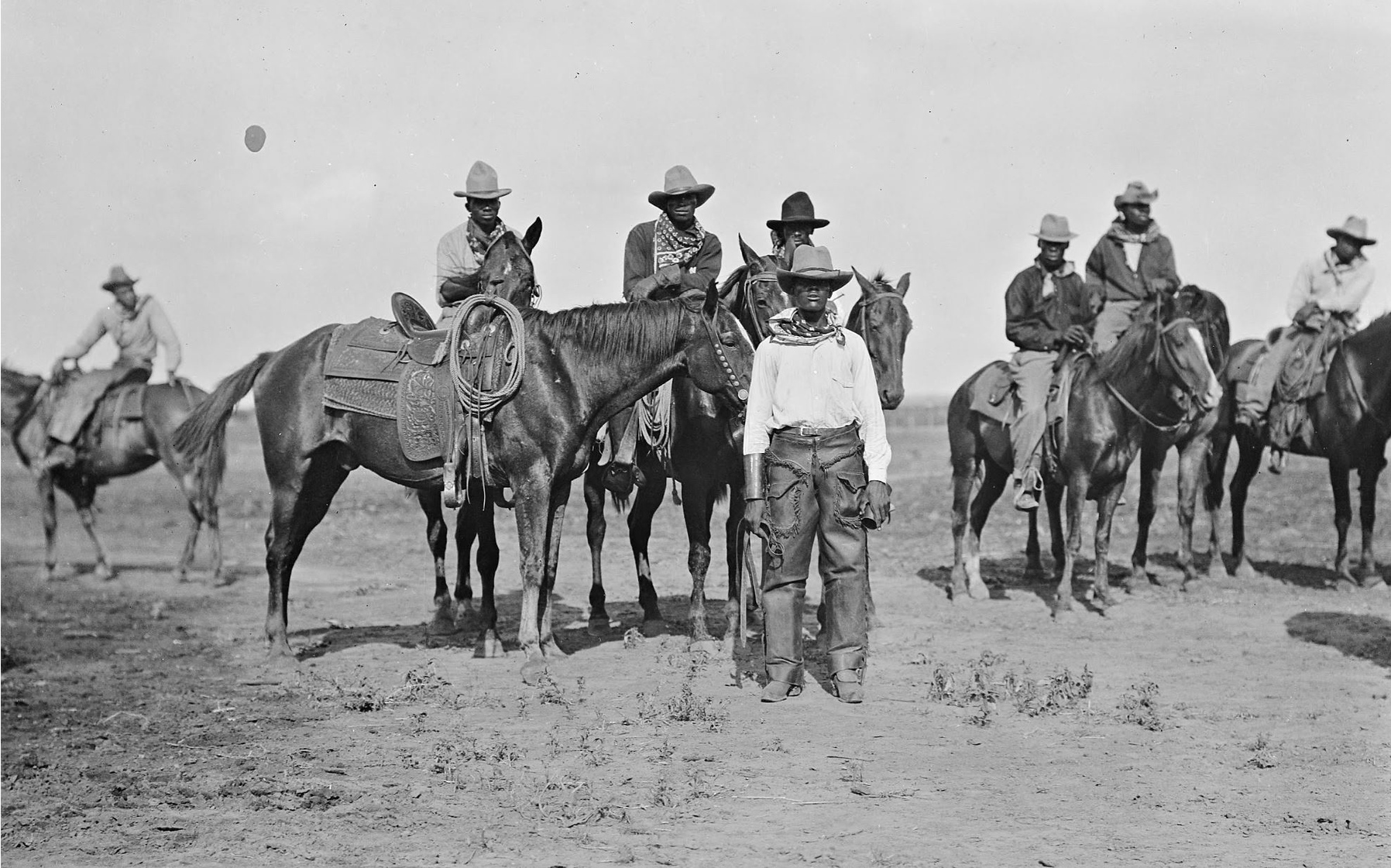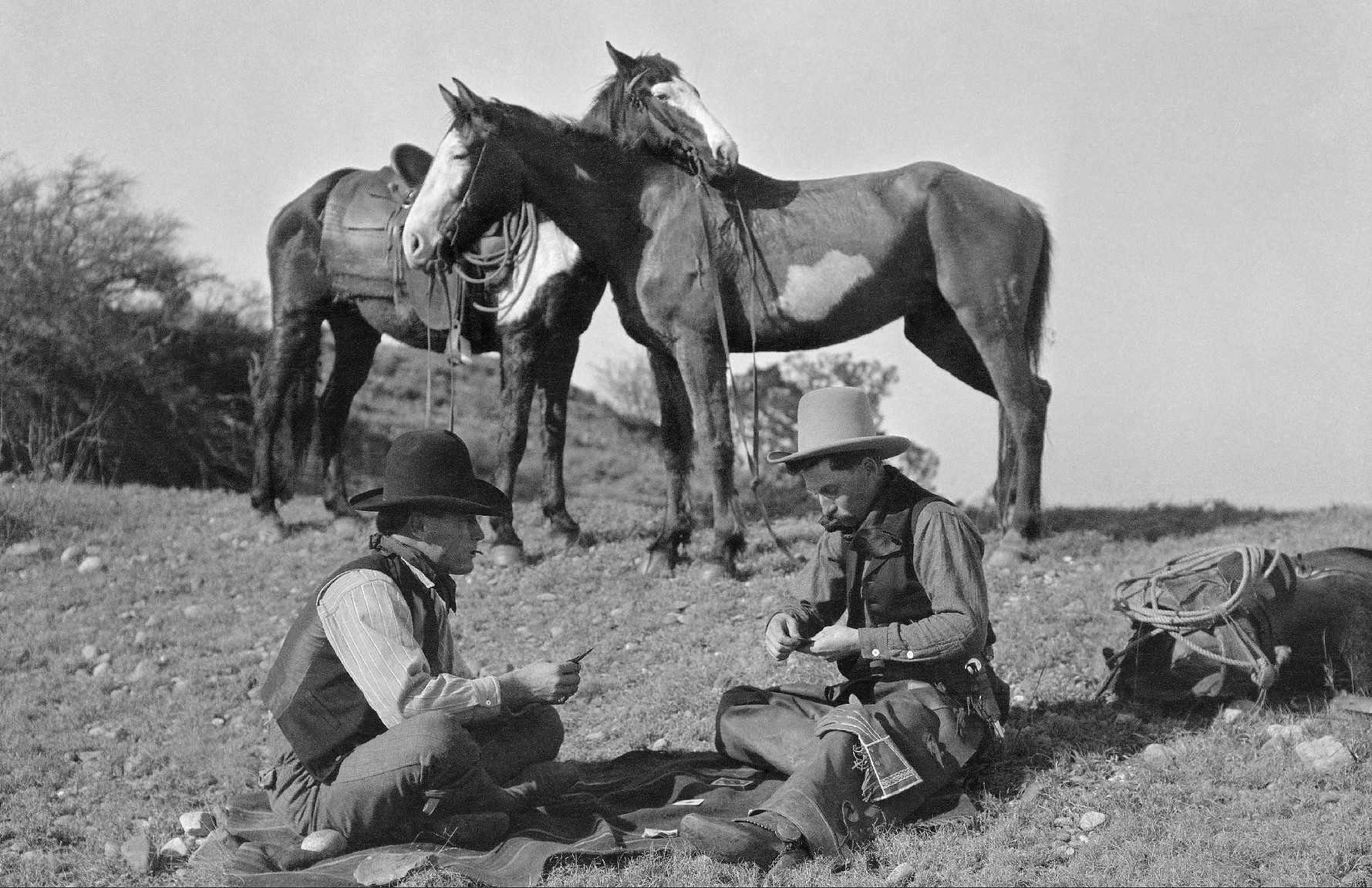Cowboys Through History
By Traces of Texas
Cowboys on the Turkey Track Ranch cross the Wichita River, 1906.
Courtesy the Amon Carter Museum of American Art in Fort Worth
In 1521 a Spanish ship arrived in what is now Mexico. In the cargo hold was a small group of cattle—six heifers and a bull, perhaps. The cattle shipper, Gregorio de Villalobos, could not have known that these cows, the first of their kind in the New World, would shape the history of North America, be the seed stock of empires, and, ultimately, lead to the creation of the cowboy.
Hundreds of years passed. Spain made several attempts to colonize what is now Texas. Mexico eventually gained independence from Spain and then Texas gained independence from Mexico. During all this tumult, cattle got loose. Being of hearty Andulasian stock, they multiplied to the point that by the decades after the Civil War, there were millions of feral cattle roaming unfenced Texas countryside.
With Eastern markets hungry for meat and local farms devastated by the war, cattlemen saw an opportunity. They started rounding up the cattle and driving them north to Kansas, where there were railheads that could ship the cattle back east. Out of this emerged the Texas cowboy, who was, in the words of historian Paul Horgan: "the last of the clearly traditional characters [born] from the kind of land he worked in and the kind of work he did."
Trail Cowboys
Although the peak era of the great cattle drives lasted for only about 20 years—between the end of the Civil War and the boom of railroads in Texas—it left a legacy of images: sun-burned cowboys in their rawhide chaps and wide-brimmed hats, bawling cattle and dusty trails, darting quarter horses keeping the cattle in line, curmudgeonly chuckwagon cooks making biscuits and black coffee over an open fire. It is the cattle drive that, more than anything else, informs our romantic notions of the Old West.
Unfortunately, because cameras and photography supplies were heavy, it's rare to find images of Texas cowboys out on the open trail. We are fortunate to have photos of them when they came to town to have their portraits taken, and some of them later in life.
By the time this tintype was made in 1878 of 18-year-old E.C. "Teddy Blue" Abbott, he was already an experienced trail cowboy. He began his career at age 10 when he went to Texas with his father to round up some of the millions of Longhorn cattle that were freely roaming in Texas. Abbott later said the experience "made a cowboy out of me. Nothing could have changed me after that." He worked on the range throughout the 1870s and 1880s. His memoir of cowboy life—from trail drives to the off-season tomfoolery in town and everything in between—was published in 1939.
An undated photo shows Texas cowboys on the trail to Kansas. An early English observer had this to say about the cowboys who rode the trail:
"I have no hesitation in warning any restless, roving spirits who may be attracted by picturesque descriptions of a cowboy's life that, unless they are prepared to toil during the long summer months, both by day and by night, for small pay on scant fare, to be in the saddle from early dawn until sunset both Sundays, to abstain from comfort and civilization for a greater part of the year, and so to wear themselves out with exposure and manifold fatigues as to be reckoned old and past their work whilst still young in years, they had better remain at home and leave cowboy life alone."
—Cowboy John Baumann in "The Fortnighly Review," April 1, 1887.
Photo courtesy Traces of Texas reader Royce Stillwell. Royce found this photo in an old book that belonged to his father.
The first annual reunion of the Old Time Trail Driver's Association in San Antonio, 1915.
The association’s members were men who, after the Civil War and before the prairies were fenced off, had driven millions of Longhorns from Texas to places like Kansas, where they could then be shipped east by railroad.
Photo courtesy the University of Texas at San Antonio
Three cowboys in the Texas Panhandle, 1901.
Photo by Western photographer William Henry Jackson
Map of the Chisholm Trail.
Courtesy Texas State Historical Association
The original creator of the Chisholm Trail and its namesake, Jesse Chisholm (circa 1805-March 4, 1868) was a Scottish-Cherokee trader who died before the heyday of the Texas-to-Kansas cattle drives. As an interpreter, he participated in key moments in history, including aiding with the treaties between the Republic of Texas and local Native Americans, as well as between the federal government and various tribes after Texas joined the United States.
Courtesy Kansas State Historical Society
An old cowboy strains to hear the conversation at a reunion of the Old Time Trail Driver's Association in San Antonio, 1938. His name was W.L. Miller, and he was 75 years old.
Courtesy University of Texas at San Antonio Digital Archives
Ranches, Ranchers, and Rodeos
After the cattle trails wound down and the open prairies were fenced off, a different kind of cowboy emerged: the ranch cowboy. It was a time when some of Texas' great cattle ranches came into being. Fortunes were made and lost depending on rainfall and the vagaries of the price of beef in faraway markets. Unlike the trail cowboy, the ranch cowboy usually had a dry place and a warm bed to sleep in, even if it was in a lonely “dugout” line cabin somewhere in the Texas Panhandle.
Cowboys are prone to “discussions” about who has the best cowboying skills. Such was the case in Pecos in 1883, when Trav Windham, a well-known roper, and Morg Livingston of the NA Ranch, got to talking about which one of them was better at roping. They decided to settle the debate on a flat land west of the Pecos River, roughly where the present-day courthouse in Pecos is located. Word spread and on July 4, folks from all directions came to witness Windham win the roping competition by roping and tying his steer in 22 seconds, then Livingston beat Windham in matched roping. Before the day was over, cowboys from the Hashknife, W, Lazy Y, and NA ranches had also taken part in the action.
And that's how the Pecos Rodeo, which claims to be the world's first, was born.
It's hard to know where to begin when talking about the life of legendary Texas rancher Charles Goodnight, but the Texas State Historical Association does a pretty good job of capturing the highlights.
Many Texans know about Charles Goodnight because he was partly the inspiration for Larry McMurtry’s Lonesome Dove character Captain Woodrow Call, who brought his friend Augustus McCrae's body all the way back from Montana to be buried in Texas. This is based on real life: Goodnight had his business partner Oliver Loving's body brought back 600 miles from New Mexico so that he could be buried in Weatherford.
University of North Texas Libraries / The Portal to Texas History; Cattle Raisers Museum
Traces of Texas reader Katy Hoskins sent in this wonderful shot of her great-grandfather Sam Graves on his horse, Hub, after winning the first cutting horse contest held at the Cowboy Reunion in Haskell in 1898.
W.D. Harper took this photo of cowboys branding calves on the XIT ranch in 1904. The XIT Ranch in the Panhandle was once the largest ranch in the world, running roughly 200 miles from north to south, up to 30 miles wide, and requiring 6000 miles of fence.
West Texas is all about wide-open spaces and infinite skies. Here we see cowboys on the R.P. Bean ranch north of Van Horn circa 1910.
This glimpse into ranch life shows the ranch houses, corral, windmill/water pump, cistern, and cowboys. I imagine that’s R.P. Bean himself facing the camera. The mountain in the background is called Turtleback Mountain. Head north on State Highway 54 out of Van Horn toward the Guadalupe Mountains, and you’ll see this mountain from very near this same perspective.
Courtesy Clark Hotel Museum / The Portal to Texas History
Casimiro Chavarria at a train depot in Marfa, 1910. Casimiro passed away in Marfa at the age of 82 and is buried there.
Courtesy Marfa Public Library / The Portal to Texas History
Vaqueros showing off three horses at what is almost certainly the La Laja Ranch near Laredo, around 1910. The ranch has been in the Vidaurri family since the 1750s. The building in the foreground has walls made from rows of stone blocks which alternate in either color or texture. On top of the walls is a thatched-roof structure. Shade is provided by tree trunks laid on a lattice of poles. To the right are two wagons. Wearing protective clothing, the vaqueros carry thick ropes. Their stirrups are made of wood.
Courtesy the collection of Irene Vidaurri Zubeck
This is Willie “Bill” Pickett (Dec. 5, 1870-April 2, 1932), a cowboy, rodeo star, Wild West show performer, and inventor of bulldogging, a technique of grabbing cattle by the horns and wrestling them to the ground. (Notice how he’s biting the bull through the lip, which is how he bulldogged.) This method lost popularity as the sport morphed into the steer wrestling practiced today.
In 1971, Pickett was inducted into the National Cowboy Hall of Fame. There is a sculpture of him bulldogging a steer in the Stockyards in Fort Worth and a statue of him on the corner of North Main and Second streets in Taylor.
Traces of Texas reader Trey Velasco graciously submitted this wonderful photo of his great uncles, Ricardo and Juan Gonzalez, in the early 1930s on the El Rancho Grande Ranch in Fort Stockton.
Trey's great-great-grandfather, Saturno Gonzalez, registered his cattle brand in Pecos County on Aug. 25, 1875. Saturno's widow, Guillerma Onsurez, registered her brand in 1889, and Isidoro Gonzalez, Trey's great grandfather, registered his brand in 1892.
Trey Velasco also shared this nice photograph of roundup time on a West Texas ranch. It is believed to be on the Kokernot 06 Ranch near Alpine but it may be elsewhere.
A vaquero eats lunch on a ranch near Marfa, 1939. Note his well-worn chaps and hard-worn boots.
Photo by Russell Lee
Get a few cowboys together and a rodeo is likely to break out. That's what happened in Pecos on July 4, 1883, and they've been rodeoing there ever since. This photo of cowboys saddling a bronc was taken at the 1936 West of the Pecos Rodeo.
Photo taken by a photographer from the Fort-Worth Star Telegram, courtesy the University of Texas-Arlington Special Collections.
A cowboy and the accoutrements he used to work on one of the SMS Ranches near Spur. The ranches, which were founded by Swante Swenson in the 1880s, occupy more than 300,000 acres across 12 Texas counties.
Photo by Russell Lee, 1939
A cowboy or rancher and his horse at the San Angelo Fat Stock Show and Rodeo, 1940.
Photo by Russell Lee
A cowboy pets his horse on the SMS Ranches near Spur, 1939. Photo by Russell Lee
The SMS Ranches in the lower plains area of West Texas were named for the initials of the founder, Swante M. Swenson, who moved to Texas from Sweden in the 1830s.
More information about the SMS Ranches is available in the online Handbook of Texas from TSHA.
Cowboys outside the Vega Cafe in Vega, 1950s.
Photo courtesy the Milburn-Price Culture Museum in Vega
Traces of Texas reader Kyle Marshall shared this photo of his uncle Benny Butler in 1964 at the SMS/Tongue River Ranch outside Paducah. Benny was a lifelong cowboy who also appeared in some TV and print advertisements. Benny was born in 1938 and died in 1995.
Traces of Texas reader Rita Ruth Ramon sent in this 1981 photo of her uncle, Richard Ramon, who was the ranch foreman on the Lazy F Ranch near Berclair.
This was taken when George H.W. Bush visited the ranch to hunt. Doesn't Richard look like he has some stories to tell?
Young Cowboys and Cowgirls
Folks from around the world “grew up a-dreamin' of bein' a cowboy / and lovin' the cowboy ways,” as Waylon and Willie once sang. One such person was Karl May, who more than 100 years after his death remains one of the best-selling German authors of all time. One of his most popular subjects? The cowboys of the Old West.
Traces of Texas reader Michael Hamilton sent in this 1954 photo of himself on his hobby horse in Breckenridge. He was 4 years old. I'm pretty sure I had this exact same ensemble.
Traces of Texas reader Kaye Solomon Partin submitted this photo found among her grandmother's things when her grandmother passed away in 1986.
Traces of Texas reader Christina Potts submitted this 1945 photo of her mother, Marisue, and her uncle, Stanley "Teen" Burleson. They grew up on the large family ranch near Matador and Floydada and, at the time Christina sent this in 2017, were both still living and working on it.
Traces of Texas reader Pamela Newton was nice enough to send in this 1954 photo of her cousins David (left) and Mike Smith, taken in Llano County.
Traces of Texas reader Terrell Glavine sent this photo of a little buckaroo and Big Tex at the State Fair of Texas in Dallas (circa 1952). Terrell didn't say if photo is of himself.
Traces of Texas reader Bill Campell sent this photo: "This picture of my wife, Colleen Hollingsworth Campbell, and her brother Richard Lewis Hollingsworth was taken at their home on Panola Street in Fort Worth in 1942. Colleen says that she believes that the owner of the pony traveled the neighborhood costuming the children and taking their pictures," Campbell said.
Traces of Texas reader Jeanette Crumpler submitted this photo of herself on a pony in Wichita Falls back in 1936. It was taken at a house on McGregor Street that her parents rented just before she and her family moved into their home on Ardath Street.
Erwin E. Smith
Erwin E. Smith (1886-1947), the greatest chronicler of cowboy life who ever lived, created action-filled images of cowboys and ranch life that have come to symbolize the many universal cowboy tropes.
Growing up in Bonham, Smith wanted to be a cowboy and an artist. He was also determined to document the open-range lifestyle before it disappeared. He studied sculpture and painting at art schools but chose photography as his primary artistic medium.
As a teenager, Smith captured ranch life between 1905 and 1912 while on summer vacations. His photographs created a photographic record of cowboys engaged in all kinds of activities. Though not a great financial success, Smith brought national attention to cowboy photographs with publication in periodicals like The Saturday Evening Post and Cattleman. In 1912, Eastman Kodak Company gave Smith recognition by using his images to showcase how impressive photography could be achieved with their simple box camera.
The photos here are from the Library of Congress' website, although their permanent home is in the Amon Carter Museum of American Art in Fort Worth.
Erwin Smith self-portrait, 1904
Black cowboys as photographed by Erwin E. Smith in 1913. The exquisite leather tooling on the saddle belonged to the dismounted cowboy.
Courtesy the Amon Carter Museum of American Art in Fort Worth
Erwin E. Smith in the doorway of a half-dugout cabin on the LS Ranch north of Amarillo, 1907. Imagine spending a cold winter in a cabin like this!
Courtesy the Amon Carter Museum of American Art in Fort Worth
A cowboy from the LS Ranch mailing a letter in 1907 has me wondering: Who picked up the mail for delivery, how did he or she travel, and how frequently did he or she make their rounds?
Courtesy the Amon Carter Museum of American Art in Fort Worth
Cowboys on the LS Ranch burn the LS brand into a white-faced Hereford calf, 1907. The LS was a 35,000-acre spread in the Panhandle counties of Oldham and Hartley.
Courtesy the Amon Carter Museum in Fort Worth
Cowboys belly up to the bar to "settle the dust" at a saloon in Tascosa in 1907.
Courtesy the Amon Carter Museum of American Art in Fort Worth
Ranch cook Harry Stewart makes a cobbler on the Matador Ranch, 1908. Ranches bought items in bulk in those days, with orders including things like "150 lbs. granulated sugar, 1000 lbs. Wichita best high patent flour, and 2 ten gallon kegs New Orleans Molasses," as listed on an 1892 order from the Rocking Chair Ranch in Aberdeen.
Courtesy the Amon Carter Museum of American Art in Fort Worth
A cowboy watches over a remuda on the SMS Ranches in 1910.
Courtesy the Amon Carter Museum of American Art in Fort Worth
We tend to think of cowboys in terms of the work they did riding the range or herding cattle, but this photo shows Charley Thompson (left) and Ed Bomar (right) playing a game of Seven-Up on the Turkey Track Ranch in 1906.
Courtesy the Amon Carter Museum of American Art in Fort Worth
This essay started with a photo of E.C. "Teddy Blue" Abbott, who wrote the memoir We Pointed Them North: Recollections of a Cowpuncher. I'm finishing with perhaps my favorite cowboy quote of all, which comes from that book:
"A man has got to be at least seventy-five years old to be a real old cowhand. I started young and I am seventy-eight. Only a few of us are left now, and they are scattered from Texas to Canada. The rest have left the wagon and gone ahead across the big divide, looking for a new range. I hope they find good water and plenty of grass. But wherever they are is where I want to go."
Teddy Blue passed away just days after he wrote these words.
Courtesy the Amon Carter Museum of American Art in Fort Worth














